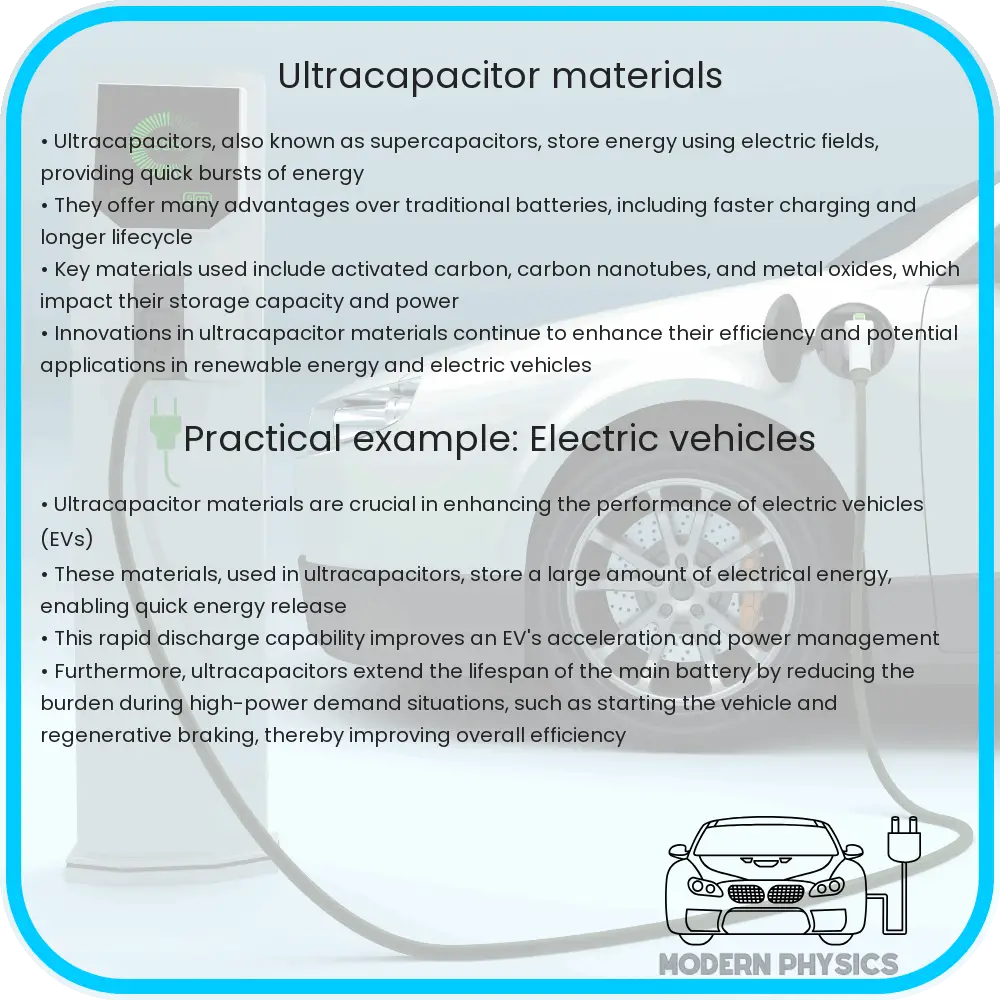Explore the role of ultracapacitor materials in enhancing the efficiency, durability, and performance of supercapacitors in energy storage.

Introduction to Ultracapacitor Materials
Ultracapacitors, also known as supercapacitors, are essential components in the field of energy storage. They stand out due to their ability to charge and discharge electricity much faster than traditional batteries, and achieve a higher number of charge-discharge cycles. Ultracapacitor materials play a critical role in their performance, including efficiency and durability. Recent innovations in these materials are setting the stage for next-generation energy storage solutions.
Efficiency of Ultracapacitor Materials
The efficiency of ultracapacitors is largely dependent on the materials used to construct them. Key materials include electrodes, electrolytes, and separators. The electrodes, often made from active carbon materials, are crucial as they provide the large surface area necessary for the storage of electrical charges. Carbon nanotubes and graphene are examples of innovative materials enhancing the energy density and electrical conductivity, making ultracapacitors more efficient.
Efficiency in ultracapacitors is often measured through metrics like specific capacitance, energy density, and power density. The energy density (W⋅h/kg), which describes how much energy a capacitor can store per unit mass, can be dramatically increased with improvements in electrode material. Similarly, power density (W/kg), indicative of how quickly stored energy can be delivered, benefits from the reduced internal resistance provided by advanced materials.
Durability of Ultracapacitor Materials
Durability is another crucial factor, dictating the lifespan and reliability of ultracapacitors under various operational conditions. Materials that can withstand high temperatures, mechanical stress, and chemical degradation contribute to more robust devices. For instance, advancements in polymer-based electrolytes and hybrid electrolytes are proving to enhance the thermal stability and chemical resistance of ultracapacitors.
The interface between electrolytes and electrodes is also vital in determining the longevity of ultracapacitors. Materials that promote stable chemistries and prevent degradation at this interface help maintain performance over many cycles of charging and discharging.
Innovation in Ultracapacitor Materials
Research and development in ultracapacitor technology continue to push the boundaries of what is possible with these energy storage devices. One area of intense focus is the development of electrode materials that surpass the performance of traditional activated carbon. Materials such as metal oxides, conducting polymers, and treated carbons are being explored for their unique properties that could lead to ultracapacitors with higher capacitance and energy densities.
Another exciting frontier is the integration of ultracapacitors with other energy storage technologies, such as batteries, to create hybrid systems. These systems aim to combine the high energy density of batteries with the high power density and durability of ultracapacitors, leading to more efficient and longer-lasting energy storage solutions.
Challenges and Future Directions
Despite the impressive advancements in ultracapacitor materials, there remain significant challenges that must be addressed to further enhance their appeal and applicability. One major challenge is the cost of high-performance materials like graphene, which remains prohibitively expensive for widespread adoption. Additionally, the scalability of manufacturing processes for advanced ultracapacitor components poses hurdles for large-scale production.
Environmental impacts also require careful consideration. As the demand for more efficient energy storage grows, the sustainability of materials used in ultracapacitors becomes increasingly vital. Researchers are therefore investigating more environmentally friendly materials that do not compromise the performance of ultracapacitors.
Educational and Commercial Impact
The ongoing developments in ultracapacitor materials not only promise to revolutionize the way we store and use energy but also have substantial educational and commercial impacts. Educational institutions are increasingly including energy storage technologies in their curriculums, preparing the next generation of engineers and scientists. Commercially, industries from automotive to renewable energy are eagerly integrating ultracapacitor technology to improve efficiency and reduce environmental footprints.
As these technologies become more mainstream, they spawn a new set of standards, regulations, and expertise, fueling job creation and new business opportunities in the field of advanced energy storage solutions.
Conclusion
The realm of ultracapacitors is witnessing rapid progress, driven by the development of innovative materials that enhance both the efficiency and durability of these devices. As we confront the challenges of cost, scalability, and environmental impact, the potential for ultracapacitors to play a pivotal role in future energy systems is undeniable. With continued research, collaboration across academic and industrial landscapes, and an eye towards sustainability, ultracapacitors are poised to become an integral component of modern energy infrastructure, ushering in a new era of energy storage solutions that are not only powerful and enduring but also environmentally conscious.
